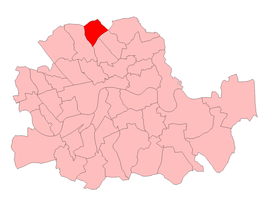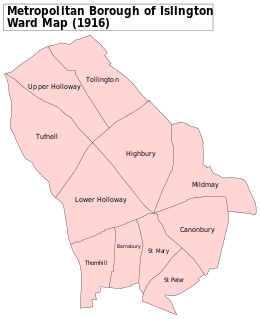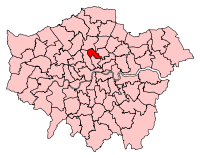Islington North is a constituency created in 1885 represented in the House of Commons of the UK Parliament since 1983 by Jeremy Corbyn of the Labour Party.[n 1] Corbyn has been Leader of the Labour Party and the Opposition since September 2015.
Political history
The constituency has at each election since a 1937 by-election elected the Labour Party candidate. Since then the smallest majority was 10.4% of the vote, in a by-election in 1969, on a very low turnout.
The MP since 1983, Jeremy Corbyn, had his smallest majority (15.3%) in 1983 and his largest (60.5%) in 2017. In the eight elections during Corbyn's tenure, the Conservatives have finished in second place four times while the Liberal Democrats have also been runners up on four occasions. The 2015 result made the seat the 26th safest of Labour's 232 seats by percentage of majority.[2]
Boundaries
1885–1918

Islington North in London 1885–1918
The seat was created by the Redistribution of Seats Act 1885, as one of four divisions of the new parliamentary borough of Islington. The constituency was defined in the legislation as consisting of the single ward of Upper Holloway of the parish of Islington. The ward was one of eight used in the election of Islington vestrymen under the Metropolis Management Act 1855.[3][4]
1918–1950

Islington North in London 1918–50
Under the next redistribution of seats by the Representation of the People Act 1918 constituencies in the County of London were defined in terms of wards of the metropolitan boroughs created in 1900. Islington North comprised three wards of the Metropolitan Borough of Islington: Tollington, Tufnell and Upper Holloway.[4][5]
1950–1974

Islington North in London 1950–74
At the next redistribution of seats by the Representation of the People Act 1948 the constituency was again defined as Tollington, Tufnell and Upper Holloway wards of the Metropolitan Borough of Islington, with boundaries as they existed at the end of 1947.[4][6]
1974–1983
In 1965 local government in Greater London was reorganised, with the formation of London boroughs. The changes were reflected in parliamentary boundaries from 1974. The London Borough of Islington was divided into three constituencies. Islington North was defined as comprising seven wards: Highview, Hillmarton, Hillrise, Junction, Parkway, St. George's and Station.[4][7]
1983–1997
In 1983 the parliamentary representation of Islington was reduced to two constituencies. The new, enlarged, Islington North was formed from ten wards of the borough as they existed in February 1983. These were Gillespie, Highbury, Highview, Hillrise, Junction, Mildmay, Quadrant, St. George's, Sussex and Tollington wards.[8]
1997–2010
In 1997 there were only slight boundary changes, with the constituency defined as the same ten wards with their boundaries as they existed on 1 June 1994.[9]
Since 2010
The seat covers the northern half of the London Borough of Islington, which includes the areas of Holloway, Highbury, Tufnell Park, Upper Holloway and Archway.
The constituency now comprises eight electoral wards:
Finsbury Park, Highbury East, Highbury West, Hillrise, Junction, Mildmay, St. George's and Tollington.[10]
These boundaries have been considerably changed since 1970, when Islington returned three MPs and shared another with Hackney. This reflects the depopulation of central London on a lowering of adult occupancy of households and the local authority has replaced tower blocks. The core of the constituency was the area north of Seven Sisters Road and Camden Road. At 0.735 square kilometres (0.284 sq mi), it is the smallest UK Parliamentary constituency.[11] At the Fifth Periodic Review of Westminster constituencies begun in 2012 the seat was approximately 1,300 electors below the electoral quota and the highest concentration of elector density nationally. The criteria of successive reviews emphasise equal electorates as well as restricting seats to one or, if unavoidable, two local authority areas.[12]
Members of Parliament
Election results
Elections in the 2010s
Elections in the 2000s
Elections in the 1990s
Elections in the 1980s
Elections in the 1970s
Elections in the 1960s
Elections in the 1950s
Elections in the 1940s
Elections in the 1930s
Elections in the 1920s

Henry Cowan
Elections in the 1910s
.jpeg)
Moore
- endorsed by Coalition Government

Touche
Elections in the 1900s

Waterlow

Rawlings
Michael O'Halloran, elected Labour MP for Islington North in 1969, was the subject of an investigation in the early 1970s by The Sunday Times newspaper. They highlighted his background with a local building company and the local Irish community and queried the tactics of his supporters during his selection as candidate.
O'Halloran joined the SDP in September 1981, as did both of the other Islington MPs. However the Boundary Commission cut the number of constituencies in Islington from three to two. O'Halloran sought selection as the SDP candidate for the revised Islington North constituency but the local SDP association selected John Grant, then SDP (elected as Labour) MP for Islington Central, as its official candidate. In February 1983, O'Halloran resigned his membership of the SDP and sat in Parliament as an "Independent Labour" member, supporting the Parliamentary Labour Party. Despite this, he failed to regain the Labour Party nomination for the 1983 General Election and he was defeated by the new Labour candidate, Jeremy Corbyn, coming fourth with 11.1% of the vote.
Corbyn defeated Paul Boateng for the Labour Party selection. Boateng subsequently became the first black cabinet minister in the UK.
See also
Notes and references
- Notes
- References
- ↑ "Electorate Figures – Boundary Commission for England". 2011 Electorate Figures. Boundary Commission for England. 4 March 2011. Archived from the original on 6 November 2010. Retrieved 13 March 2011.
- ↑ List of Labour MPs elected in 2015 by % majority UK Political.info. Retrieved 2017-01-29
- ↑ Redistribution Of Seats Act, 1885. Sixth Schedule. Divisions Of Boroughs. Number, Names, Contents, And Boundaries Of Divisions.
- 1 2 3 4 Youngs, Frederic A, Jr. (1979). Guide to the Local Administrative Units of England, Vol.I: Southern England. London: Royal Historical Society. pp. 743, 746, 749. ISBN 0-901050-67-9.
- ↑ Representation Of The People Act 1918. Ninth Schedule. Redistribution Of Seats.
- ↑ Representation Of The People Act 1948, First Schedule. Parliamentary Constituencies.
- ↑ The Parliamentary Constituencies (England) Order 1970 (S.I. 1970/1674)
- ↑ The Parliamentary Constituencies (England) Order 1983 (S.I. 1983/417)
- ↑ "The Parliamentary Constituencies (England) Order 1995 (S.I. 1995/1626)". legislation.gov.uk. The National Archives (United Kingdom). Retrieved 27 May 2013.
- ↑ "The Parliamentary Constituencies (England) Order 2007 (S.I. 2007/1681)". legislation.gov.uk. The National Archives (United Kingdom). Retrieved 27 May 2013.
- ↑ Parliamentary constituencies, UK Parliament; Accessed 12 August 2015
- ↑ "Fifth Periodical Report" (PDF).
- ↑ Leigh Rayment's Historical List of MPs – Constituencies beginning with "T" (part 1)
- ↑ "Statement of persons nominated, notice of poll and situation of polling stations" (PDF). Islington London Borough Council. 11 May 2017. Retrieved 8 June 2017.
- ↑ "Election Data 2015". Electoral Calculus. Archived from the original on 17 October 2015. Retrieved 17 October 2015.
- ↑ Islington Council Archived 4 March 2016 at the Wayback Machine.
- ↑ General Election – Campaign News Socialist Party of Great Britain, 15 January 2015
- ↑ "Election Data 2010". Electoral Calculus. Archived from the original on 26 July 2013. Retrieved 17 October 2015.
- ↑ Islington Council Archived 3 March 2012 at the Wayback Machine.
- ↑ "Election Data 2005". Electoral Calculus. Archived from the original on 15 October 2011. Retrieved 18 October 2015.
- ↑ "Election Data 2001". Electoral Calculus. Archived from the original on 15 October 2011. Retrieved 18 October 2015.
- ↑ "Election Data 1997". Electoral Calculus. Archived from the original on 15 October 2011. Retrieved 18 October 2015.
- ↑ "Election Data 1992". Electoral Calculus. Archived from the original on 15 October 2011. Retrieved 18 October 2015.
- ↑ "Election Data 1987". Electoral Calculus. Archived from the original on 15 October 2011. Retrieved 18 October 2015.
- ↑ "Election Data 1983". Electoral Calculus. Archived from the original on 15 October 2011. Retrieved 18 October 2015.
- ↑ British Parliamentary Election Results 1918–1949, FWS Craig
- 1 2 3 4 British Parliamentary Election Results 1885–1918, FWS Craig
Bibliography
- Iain Dale, ed. (2003). The Times House of Commons 1929, 1931, 1935. Politico's (reprint). ISBN 1-84275-033-X.
- The Times House of Commons 1945. The Times. 1945.
- The Times House of Commons 1950. The Times. 1950.
- The Times House of Commons 1955. The Times. 1955.
- Craig, F. W. S. (1983) [1969]. British parliamentary election results 1918–1949 (3rd ed.). Chichester: Parliamentary Research Services. ISBN 0-900178-06-X.
|
|---|
|
| Leadership | | |
|---|
| Politics | |
|---|
| Policies | |
|---|
| Elections | |
|---|
| Family | |
|---|
| In the media | |
|---|
-
 Category Category
|
|
|---|
| 1885 | |
|---|
| 1918 | |
|---|
| 1950 | |
|---|
| 1955 | |
|---|
| 1974 | |
|---|
| 1983 | |
|---|
| 1997 | |
|---|
Coordinates: 51°33′40″N 0°06′50″W / 51.561°N 0.114°W / 51.561; -0.114





.jpeg)





